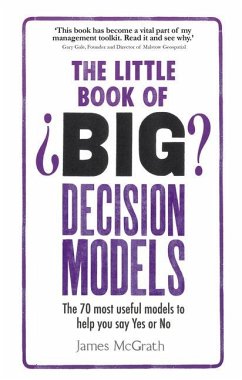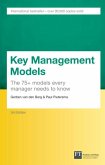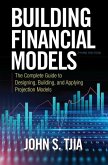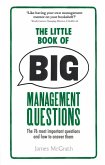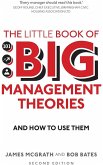James McGrath
Little Book of Big Decision Models, The
The 70 most useful models to help you say Yes or No
17,99 €
inkl. MwSt.
Versandfertig in 2-4 Wochen

9 °P sammeln
James McGrath
Little Book of Big Decision Models, The
The 70 most useful models to help you say Yes or No
- Broschiertes Buch
- Merkliste
- Auf die Merkliste
- Bewerten Bewerten
- Teilen
- Produkt teilen
- Produkterinnerung
- Produkterinnerung
Leaders and Managers want quick answers, quick ways to reach solutions, ways and means to access knowledge that won't eat into their precious time and quick ideas that deliver a big result. The Little Book of Big Decision Models cuts through all the noise and gives managers access to the very best decision-making models that they need to to keep things moving forward. Every model is quick and easy to read and delivers the essential information and know-how quickly, efficiently and memorably.
Andere Kunden interessierten sich auch für
![Key MBA Models, Travel Edition Key MBA Models, Travel Edition]() Julian BirkinshawKey MBA Models, Travel Edition27,99 €
Julian BirkinshawKey MBA Models, Travel Edition27,99 €![Key Management Models, Travel Edition Key Management Models, Travel Edition]() Gerben Van den BergKey Management Models, Travel Edition27,99 €
Gerben Van den BergKey Management Models, Travel Edition27,99 €![Stats: Data and Models, Global Edition Stats: Data and Models, Global Edition]() Richard De VeauxStats: Data and Models, Global Edition111,99 €
Richard De VeauxStats: Data and Models, Global Edition111,99 €![Classroom Management: Models, Applications and Cases Classroom Management: Models, Applications and Cases]() M. ManningClassroom Management: Models, Applications and Cases98,99 €
M. ManningClassroom Management: Models, Applications and Cases98,99 €![Building Financial Models, Third Edition: The Complete Guide to Designing, Building, and Applying Projection Models Building Financial Models, Third Edition: The Complete Guide to Designing, Building, and Applying Projection Models]() John S. TjiaBuilding Financial Models, Third Edition: The Complete Guide to Designing, Building, and Applying Projection Models101,99 €
John S. TjiaBuilding Financial Models, Third Edition: The Complete Guide to Designing, Building, and Applying Projection Models101,99 €![Little Book of Big Management Questions, The Little Book of Big Management Questions, The]() James McGrathLittle Book of Big Management Questions, The19,99 €
James McGrathLittle Book of Big Management Questions, The19,99 €![The Little Book of Big Management Theories The Little Book of Big Management Theories]() James McGrathThe Little Book of Big Management Theories17,99 €
James McGrathThe Little Book of Big Management Theories17,99 €-
-
-
Leaders and Managers want quick answers, quick ways to reach solutions, ways and means to access knowledge that won't eat into their precious time and quick ideas that deliver a big result. The Little Book of Big Decision Models cuts through all the noise and gives managers access to the very best decision-making models that they need to to keep things moving forward. Every model is quick and easy to read and delivers the essential information and know-how quickly, efficiently and memorably.
Hinweis: Dieser Artikel kann nur an eine deutsche Lieferadresse ausgeliefert werden.
Hinweis: Dieser Artikel kann nur an eine deutsche Lieferadresse ausgeliefert werden.
Produktdetails
- Produktdetails
- Verlag: Pearson Education Limited
- Seitenzahl: 224
- Erscheinungstermin: 5. November 2015
- Englisch
- Abmessung: 215mm x 136mm x 17mm
- Gewicht: 344g
- ISBN-13: 9781292098364
- ISBN-10: 1292098368
- Artikelnr.: 43042870
- Herstellerkennzeichnung
- Libri GmbH
- Europaallee 1
- 36244 Bad Hersfeld
- gpsr@libri.de
- Verlag: Pearson Education Limited
- Seitenzahl: 224
- Erscheinungstermin: 5. November 2015
- Englisch
- Abmessung: 215mm x 136mm x 17mm
- Gewicht: 344g
- ISBN-13: 9781292098364
- ISBN-10: 1292098368
- Artikelnr.: 43042870
- Herstellerkennzeichnung
- Libri GmbH
- Europaallee 1
- 36244 Bad Hersfeld
- gpsr@libri.de
James McGrath worked as an accountant and senior manager in industry, local government and as a self-employed management consultant before becoming Course Director for the MA in Education and Professional Development at the City of Birmingham University.
* Chapter 1 - The principles of decision making
* Introduction
* Model 1: Townsend’s rules of decision making
* Model 2: The McNamara fallacy - The vital information that decision
makers ignore
* Model 3: Using quantitative (hard) and qualitative (soft) data in
decision making
* Model 4: Kreiner and Christensen the consequence model
* Model 5: Tenenbaum and Schmid’s decision making spectrum
* Model 6: Roger and Blenko’s rapid decision making model
* Model 7: Cognitive mapping - understanding how your colleagues think
* Model 8: Tacit knowledge and decision making
* Model 9: The standard decision making model
* Conclusion
* Chapter 2 - Using data in decision making
* Introduction
* Model 10: The Pareto principle and the important vital few
* Model 11: Lewin’s force field analysis of the support and opposition
to a decision
* Model 12: Scenario analysis and charting possible futures
* Model 13: Delphic forecasting and how to firm up predictions
* Model 14: Johnson, Scholes and Wittingham mapping stakeholder’s
reactions
* Model 15: Egan’s shadow side model - dealing with the politics of
decisions
* Model 16: The SCAMPER model and finding creative solutions
* Model 17: De Bono’s six thinking hats - generating different
perspectives
* Conclusions
* Chapter 3 - Enhancing your decision making skills
* Intrduction
* Model 18: The Eisenhower principle and the delegation of decisions
* Model 19: The feedback and criticism grid
* Model 20: Learning to think outside the box
* Model 21: Goleman: Using emotional intelligence to make better
decisions
* Model 22: Sumantra and Bruch reclaiming your job
* Conclusion
* Chapter 4 - Decisions models about you
* Introduction
* Model 23: Christensen’s strategy for a happy life
* Model 24: The making – of you model and how your past influences the
present
* Model 25: The rubber band model - what holds you back and pulls you
forward?
* Model 26: The crossroads model and which road to follow next
* Model 27: The personal performance model and job satisfaction
* Model 28: Csikzenmihalyi’s flow model and the joy of working in ‘the
zone’
* Model 29: Maslow’s Pyramids - what you want and what you need
* Model 30: The Euffe Elbaek model - a guide to your personality
* Model 31: Johari windows - a guide to your personality
* Model 32: The personal potential trap and how to avoid becoming a
prisoner of other peoples’ expectations
* Model 33: Your attitude to risk
* Conclusion
* Chapter 5 - Decision Models about other people
* Introduction
* Model 34: Goffee and Jones - why should anyone be led by you?
* Model 35: Hersey and Blanchard’s situational leadership model
* Model 36: Manzoni and Barsoux - how managers set staff up to fail
* Model 37: Denseraeu, Graen and Haga - how managers set staff up to
succeed
* Model 38: Herzberg’s motivation and hygiene theory - choosing the
right carrots
* Model 39: The feedback sandwich - delivering negative feedback
* Model 40: McGregor’s features of effective and ineffective teams
* Model 41: The team model - building a well balanced team
* Conclusion
* Cha
* Introduction
* Model 1: Townsend’s rules of decision making
* Model 2: The McNamara fallacy - The vital information that decision
makers ignore
* Model 3: Using quantitative (hard) and qualitative (soft) data in
decision making
* Model 4: Kreiner and Christensen the consequence model
* Model 5: Tenenbaum and Schmid’s decision making spectrum
* Model 6: Roger and Blenko’s rapid decision making model
* Model 7: Cognitive mapping - understanding how your colleagues think
* Model 8: Tacit knowledge and decision making
* Model 9: The standard decision making model
* Conclusion
* Chapter 2 - Using data in decision making
* Introduction
* Model 10: The Pareto principle and the important vital few
* Model 11: Lewin’s force field analysis of the support and opposition
to a decision
* Model 12: Scenario analysis and charting possible futures
* Model 13: Delphic forecasting and how to firm up predictions
* Model 14: Johnson, Scholes and Wittingham mapping stakeholder’s
reactions
* Model 15: Egan’s shadow side model - dealing with the politics of
decisions
* Model 16: The SCAMPER model and finding creative solutions
* Model 17: De Bono’s six thinking hats - generating different
perspectives
* Conclusions
* Chapter 3 - Enhancing your decision making skills
* Intrduction
* Model 18: The Eisenhower principle and the delegation of decisions
* Model 19: The feedback and criticism grid
* Model 20: Learning to think outside the box
* Model 21: Goleman: Using emotional intelligence to make better
decisions
* Model 22: Sumantra and Bruch reclaiming your job
* Conclusion
* Chapter 4 - Decisions models about you
* Introduction
* Model 23: Christensen’s strategy for a happy life
* Model 24: The making – of you model and how your past influences the
present
* Model 25: The rubber band model - what holds you back and pulls you
forward?
* Model 26: The crossroads model and which road to follow next
* Model 27: The personal performance model and job satisfaction
* Model 28: Csikzenmihalyi’s flow model and the joy of working in ‘the
zone’
* Model 29: Maslow’s Pyramids - what you want and what you need
* Model 30: The Euffe Elbaek model - a guide to your personality
* Model 31: Johari windows - a guide to your personality
* Model 32: The personal potential trap and how to avoid becoming a
prisoner of other peoples’ expectations
* Model 33: Your attitude to risk
* Conclusion
* Chapter 5 - Decision Models about other people
* Introduction
* Model 34: Goffee and Jones - why should anyone be led by you?
* Model 35: Hersey and Blanchard’s situational leadership model
* Model 36: Manzoni and Barsoux - how managers set staff up to fail
* Model 37: Denseraeu, Graen and Haga - how managers set staff up to
succeed
* Model 38: Herzberg’s motivation and hygiene theory - choosing the
right carrots
* Model 39: The feedback sandwich - delivering negative feedback
* Model 40: McGregor’s features of effective and ineffective teams
* Model 41: The team model - building a well balanced team
* Conclusion
* Cha
* Chapter 1 - The principles of decision making
* Introduction
* Model 1: Townsend’s rules of decision making
* Model 2: The McNamara fallacy - The vital information that decision
makers ignore
* Model 3: Using quantitative (hard) and qualitative (soft) data in
decision making
* Model 4: Kreiner and Christensen the consequence model
* Model 5: Tenenbaum and Schmid’s decision making spectrum
* Model 6: Roger and Blenko’s rapid decision making model
* Model 7: Cognitive mapping - understanding how your colleagues think
* Model 8: Tacit knowledge and decision making
* Model 9: The standard decision making model
* Conclusion
* Chapter 2 - Using data in decision making
* Introduction
* Model 10: The Pareto principle and the important vital few
* Model 11: Lewin’s force field analysis of the support and opposition
to a decision
* Model 12: Scenario analysis and charting possible futures
* Model 13: Delphic forecasting and how to firm up predictions
* Model 14: Johnson, Scholes and Wittingham mapping stakeholder’s
reactions
* Model 15: Egan’s shadow side model - dealing with the politics of
decisions
* Model 16: The SCAMPER model and finding creative solutions
* Model 17: De Bono’s six thinking hats - generating different
perspectives
* Conclusions
* Chapter 3 - Enhancing your decision making skills
* Intrduction
* Model 18: The Eisenhower principle and the delegation of decisions
* Model 19: The feedback and criticism grid
* Model 20: Learning to think outside the box
* Model 21: Goleman: Using emotional intelligence to make better
decisions
* Model 22: Sumantra and Bruch reclaiming your job
* Conclusion
* Chapter 4 - Decisions models about you
* Introduction
* Model 23: Christensen’s strategy for a happy life
* Model 24: The making – of you model and how your past influences the
present
* Model 25: The rubber band model - what holds you back and pulls you
forward?
* Model 26: The crossroads model and which road to follow next
* Model 27: The personal performance model and job satisfaction
* Model 28: Csikzenmihalyi’s flow model and the joy of working in ‘the
zone’
* Model 29: Maslow’s Pyramids - what you want and what you need
* Model 30: The Euffe Elbaek model - a guide to your personality
* Model 31: Johari windows - a guide to your personality
* Model 32: The personal potential trap and how to avoid becoming a
prisoner of other peoples’ expectations
* Model 33: Your attitude to risk
* Conclusion
* Chapter 5 - Decision Models about other people
* Introduction
* Model 34: Goffee and Jones - why should anyone be led by you?
* Model 35: Hersey and Blanchard’s situational leadership model
* Model 36: Manzoni and Barsoux - how managers set staff up to fail
* Model 37: Denseraeu, Graen and Haga - how managers set staff up to
succeed
* Model 38: Herzberg’s motivation and hygiene theory - choosing the
right carrots
* Model 39: The feedback sandwich - delivering negative feedback
* Model 40: McGregor’s features of effective and ineffective teams
* Model 41: The team model - building a well balanced team
* Conclusion
* Cha
* Introduction
* Model 1: Townsend’s rules of decision making
* Model 2: The McNamara fallacy - The vital information that decision
makers ignore
* Model 3: Using quantitative (hard) and qualitative (soft) data in
decision making
* Model 4: Kreiner and Christensen the consequence model
* Model 5: Tenenbaum and Schmid’s decision making spectrum
* Model 6: Roger and Blenko’s rapid decision making model
* Model 7: Cognitive mapping - understanding how your colleagues think
* Model 8: Tacit knowledge and decision making
* Model 9: The standard decision making model
* Conclusion
* Chapter 2 - Using data in decision making
* Introduction
* Model 10: The Pareto principle and the important vital few
* Model 11: Lewin’s force field analysis of the support and opposition
to a decision
* Model 12: Scenario analysis and charting possible futures
* Model 13: Delphic forecasting and how to firm up predictions
* Model 14: Johnson, Scholes and Wittingham mapping stakeholder’s
reactions
* Model 15: Egan’s shadow side model - dealing with the politics of
decisions
* Model 16: The SCAMPER model and finding creative solutions
* Model 17: De Bono’s six thinking hats - generating different
perspectives
* Conclusions
* Chapter 3 - Enhancing your decision making skills
* Intrduction
* Model 18: The Eisenhower principle and the delegation of decisions
* Model 19: The feedback and criticism grid
* Model 20: Learning to think outside the box
* Model 21: Goleman: Using emotional intelligence to make better
decisions
* Model 22: Sumantra and Bruch reclaiming your job
* Conclusion
* Chapter 4 - Decisions models about you
* Introduction
* Model 23: Christensen’s strategy for a happy life
* Model 24: The making – of you model and how your past influences the
present
* Model 25: The rubber band model - what holds you back and pulls you
forward?
* Model 26: The crossroads model and which road to follow next
* Model 27: The personal performance model and job satisfaction
* Model 28: Csikzenmihalyi’s flow model and the joy of working in ‘the
zone’
* Model 29: Maslow’s Pyramids - what you want and what you need
* Model 30: The Euffe Elbaek model - a guide to your personality
* Model 31: Johari windows - a guide to your personality
* Model 32: The personal potential trap and how to avoid becoming a
prisoner of other peoples’ expectations
* Model 33: Your attitude to risk
* Conclusion
* Chapter 5 - Decision Models about other people
* Introduction
* Model 34: Goffee and Jones - why should anyone be led by you?
* Model 35: Hersey and Blanchard’s situational leadership model
* Model 36: Manzoni and Barsoux - how managers set staff up to fail
* Model 37: Denseraeu, Graen and Haga - how managers set staff up to
succeed
* Model 38: Herzberg’s motivation and hygiene theory - choosing the
right carrots
* Model 39: The feedback sandwich - delivering negative feedback
* Model 40: McGregor’s features of effective and ineffective teams
* Model 41: The team model - building a well balanced team
* Conclusion
* Cha
